Welcome to the world of black and orange birds, a fascinating and diverse group of avian species that captivate birdwatchers and nature enthusiasts alike. From their striking plumage to their unique behaviors, black and orange birds offer a world of discovery and wonder.
Have you ever wondered what makes these birds so special? How can you identify them? Where can you find them? And what makes them migrate thousands of miles each year? In this comprehensive guide, we will delve into the world of black and orange birds, providing you with insights on species, migration patterns, and tips for spotting them in the wild.
But first, let’s take a moment to appreciate the stunning beauty of these birds. Feast your eyes on this magnificent image of a black and orange bird:
Prepare to embark on a journey of discovery as we unravel the mysteries of black and orange birds. From their unique features to their incredible migratory journeys, this guide will deepen your understanding and appreciation of these mesmerizing creatures. So, let’s dive in and explore the enchanting world of black and orange birds together.
Red-winged Blackbird
The red-winged blackbird is a common black and orange bird found in North America. The males have a black body with **reddish-orange wing patches**, while the females have **brown streaky coloring**. They are known for their territorial behavior during breeding season and can be spotted **sitting on telephone wires**. Red-winged blackbirds **migrate in large numbers during winter** and can be attracted to backyard feeders with **mixed grain and seeds**.
If you’re interested in observing the red-winged blackbird and learning more about its migration patterns and interesting behaviors, grab your binoculars and head out to their favored habitats. Keep an eye out for these stunning birds perched on wires or flying low over marshes and wetlands.
Did you know that the red-winged blackbird is one of the **most abundant bird species** in North America, with populations estimated to be in the **tens of millions**? Their unmistakable calls and striking plumage make them a favorite among birdwatchers and photographers alike.
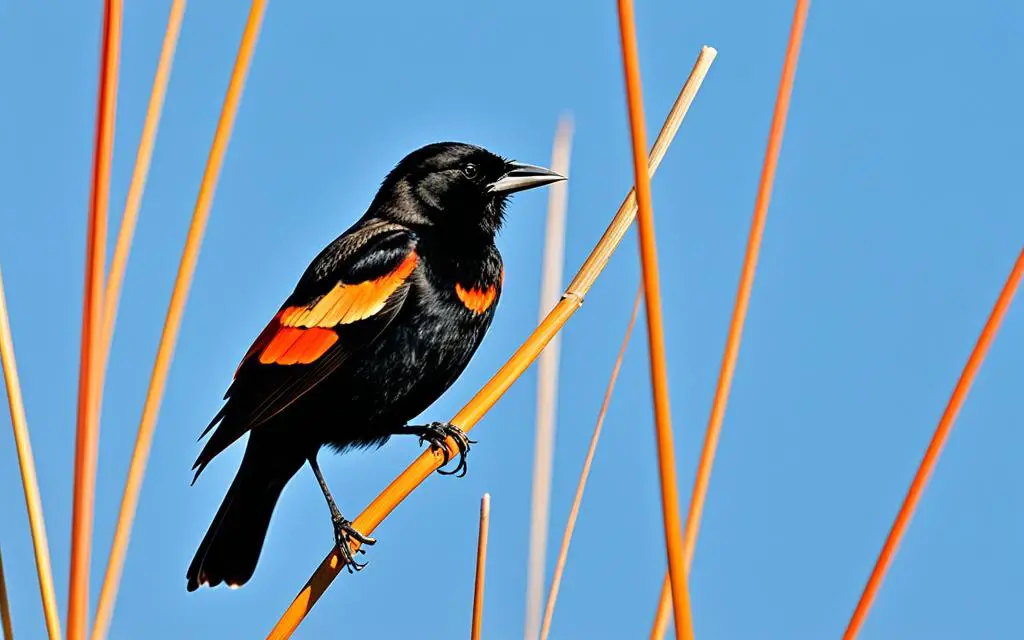
Immerse yourself in the world of birdwatching and capture breathtaking moments with the red-winged blackbird, showcasing its vibrant colors and unique behaviors.
Baltimore Oriole
The Baltimore Oriole is a vibrant black and orange bird that signals the arrival of spring in the eastern parts of North America. With their bright orange and black plumage, it’s hard to miss these stunning birds. The males have distinctive white wing bars that add to their striking appearance, while the females showcase a beautiful yellowish color underneath.
One of the most fascinating aspects of the Baltimore Oriole is its nest-building behavior. They construct incredible hanging bag-like nests woven from fibers, creating a cozy and secure home for their young. This unique behavior showcases the resourcefulness and ingenuity of these birds.
If you’re interested in bird photography, capturing the beauty of a Baltimore Oriole can be a rewarding experience. Their vibrant colors and intricate nest structures make for compelling subjects. Remember to be patient and observant to capture the perfect shot of these captivating birds.
Attracting Baltimore Orioles to Your Backyard
If you want to attract Baltimore Orioles to your backyard, consider providing specific food sources. A favorite treat for these birds is fresh oranges or sugar water. Set up a feeder with these offerings to entice them to visit. Placing the feeder near trees or shrubs can create a welcoming environment, mimicking their natural habitat of open woodlands and forest edges.
Additionally, keep in mind that Baltimore Orioles are migratory birds. They typically arrive in North America in the spring and return to their wintering grounds in Central and South America during the fall. By providing food and creating a suitable habitat, you can increase the chances of attracting these beautiful birds during their migration periods.
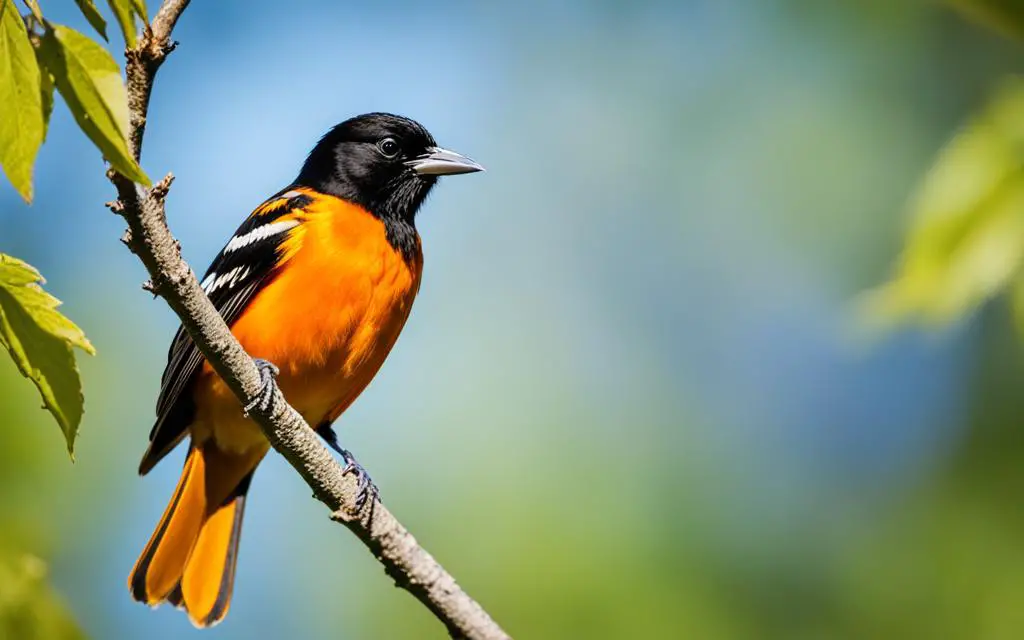
Bullock’s Oriole
The Bullock’s Oriole is a vibrant black and orange bird that can be found in the western half of the United States. With its bright orange and black plumage, the male Bullock’s Oriole is a stunning sight to behold. The females, although less flashy, still possess a unique beauty with their duller coloring, gray backs, and yellow heads. These orioles are known for their exceptional nest-building skills, constructing gourd-shaped nests woven from hair, grass, and wool.
If you’re a birdwatching enthusiast or a bird photographer, capturing the Bullock’s Oriole in action can be a rewarding experience. You can spot these birds in open woodlands and parks, where they often dwell.
| Species | Plumage | Nest | Preferred Habitat |
|---|---|---|---|
| Bullock’s Oriole | Bright orange and black plumage for males; duller coloring with gray backs and yellow heads for females | Gourd-shaped nests woven from hair, grass, and wool | Open woodlands and parks |
To attract Bullock’s Orioles to your backyard, consider setting up feeders with fruit and grape jelly. Their sweet tooth will draw them in for a delightful spectacle. And if you’re lucky, you may even catch a glimpse of their impressive nest-building activities.
Did You Know?
“The Bullock’s Oriole’s intricate nest weaving is a marvel of avian architecture, showcasing both their ingenuity and craftsmanship.”
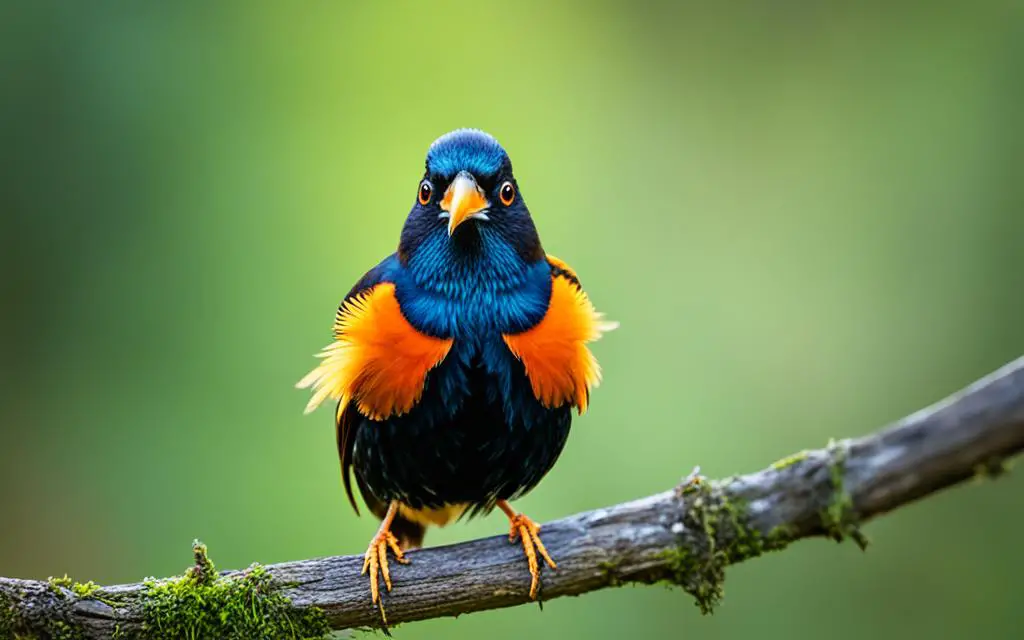
Observing the Bullock’s Oriole’s behavior and studying their migration patterns can provide valuable insights into their fascinating lives. Whether you’re an avid birder or a casual nature enthusiast, the Bullock’s Oriole is a species worth exploring.
Hooded Oriole
The hooded oriole is a medium-sized black and orange bird found in the southern United States. These stunning birds add a vibrant touch to their surroundings with their bright plumage and distinctive behavior.
The males of the hooded oriole can range from bright yellow to bright orange, with black throats and backs. Females, on the other hand, have a more yellowish appearance with grayish wings.
One of the notable features of the hooded oriole is their unique nesting behavior. They build high hanging basket-like nests woven from grass and plant materials. This architectural marvel can be a sight to behold!
If you’re an avid bird photographer, capturing the hooded oriole in action can be a rewarding endeavor. Their vibrant colors and interesting nesting behavior make for stunning photographs.
The hooded orioles are known to migrate, and they often search for food in dry open areas near palm trees. To attract them to your yard, consider setting up nectar feeders or offering fruits that they can indulge in.
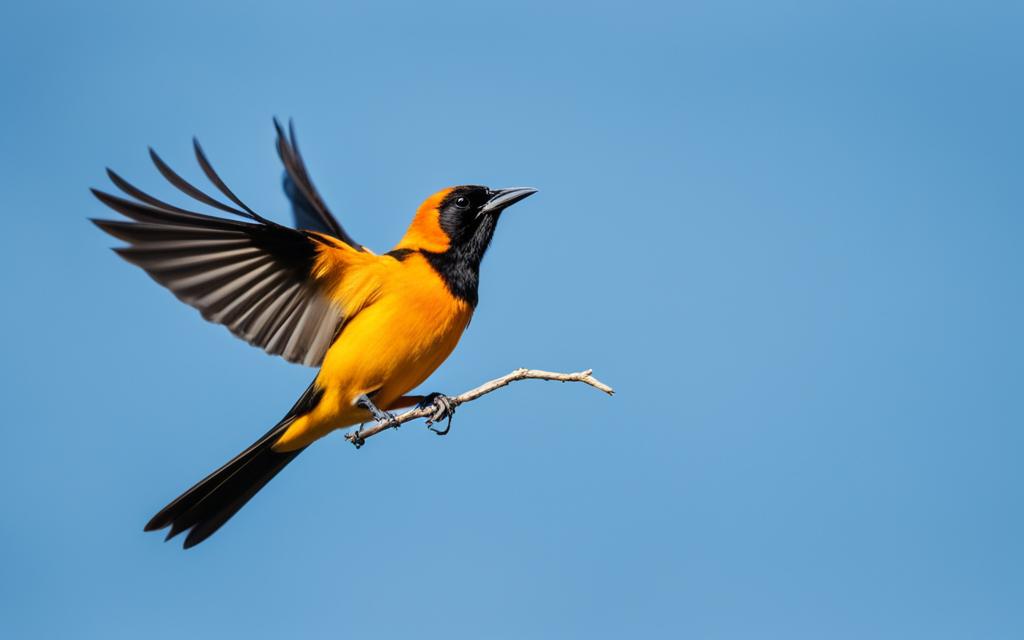
Quick Facts: Hooded Oriole
| Common Name | Hooded Oriole |
|---|---|
| Scientific Name | Icterus cucullatus |
| Size | 8 inches (20 cm) |
| Color | Bright yellow to bright orange with black throats and backs (males); yellow with grayish wings (females) |
| Habitat | Dry open areas with palm trees |
| Nesting Behavior | High hanging basket-like nests woven from grass and plant materials |
| Migration Pattern | Yes |
| Food Preferences | Nectar, fruits |
Orchard Oriole
The orchard oriole is a small black and orange bird that can be found in the central and eastern parts of North America. It is known for its striking plumage and interesting behaviors. The males of this species have black heads and backs, and reddish-orange bellies, while the females are greenish-yellow overall.
Orchard orioles are skilled nest builders and create hanging pouch-like nests. They prefer habitats such as open woodlands and areas along river banks where they can find suitable trees and vegetation to build their nests.
Not only are these birds visually appealing, but they also serve a beneficial purpose in the ecosystem. Orchard orioles help control insect populations by feeding on insects and spiders. This makes them a valuable asset in any garden or orchard.
If you’re a birdwatching enthusiast or into bird photography, the orchard oriole is a delightful subject to observe and capture. Its vibrant colors and unique behaviors make it a standout species among black and orange birds.
To attract orchard orioles to your backyard, you can set up nectar feeders or provide fruit as bait. These birds can be attracted to oranges, apple slices, or grape jelly. By creating a welcoming environment with the right resources, you can create opportunities for up-close encounters and stunning photographs of these beautiful birds.
Take a look at the image below to see the captivating orchard oriole in all its glory:
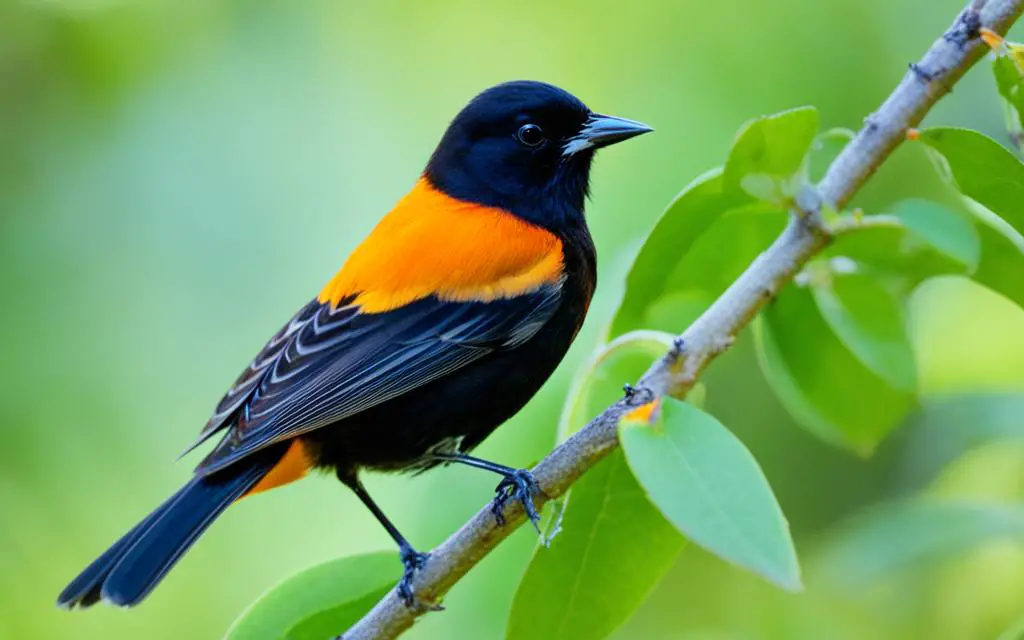
“The orchard oriole’s vibrant colors and graceful movements make it a joy to watch. It’s a true gem among the black and orange bird species.” – Birdwatcher Magazine
Altamira Oriole
The Altamira Oriole is a magnificent bird known for its vibrant yellowish-orange and black plumage. This striking species is predominantly found in the southern part of the United States, particularly in the Rio Grande Valley of Texas.
One of the remarkable features of the Altamira Oriole is its exceptional nesting behavior. These birds construct incredible hanging nests, measuring up to 2 feet long. These intricately woven structures are a sight to behold, showcasing the remarkable craftsmanship of this species.
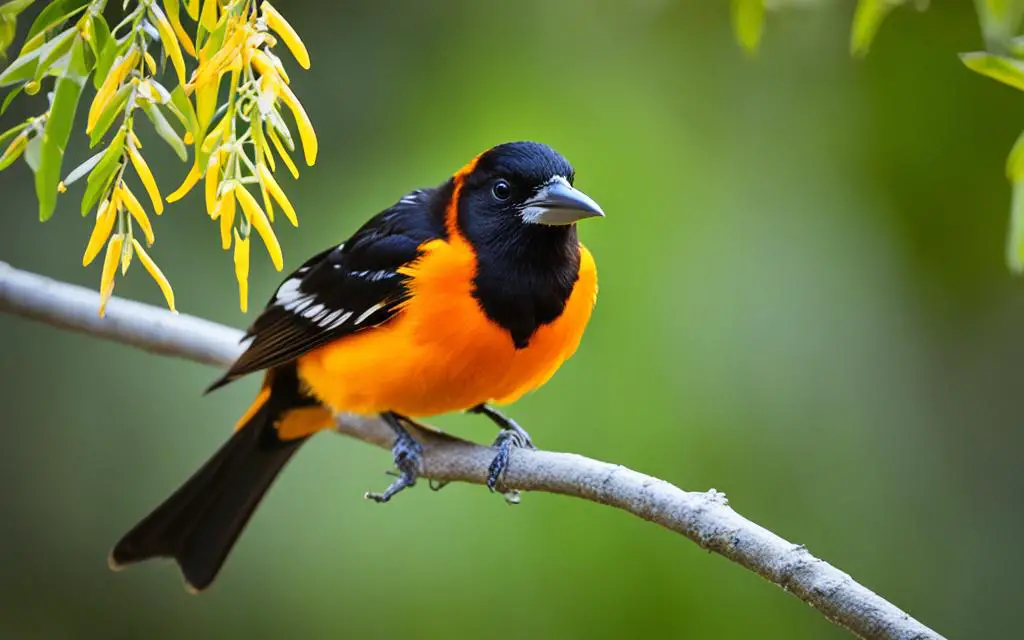
When it comes to attracting Altamira Orioles, providing feeding platforms with fruit can be particularly effective. These delightful birds are often spotted in open woodlands, where they flit about in search of nourishment. With their vibrant colors and graceful flights, Altamira Orioles make excellent subjects for bird photography.
Unlike some migratory birds, Altamira Orioles stay in pairs year-round. This makes them a consistent presence in certain regions, adding a touch of vibrancy to the natural landscape.
The Altamira Oriole at a Glance
| Common Name | Altamira Oriole |
|---|---|
| Scientific Name | Icterus gularis |
| Family | Icteridae |
| Coloration | Bright yellowish-orange and black plumage |
| Habitat | Open woodlands |
| Behavior | Builds hanging nests; stays in pairs year-round |
| Attraction | Feeding platforms with fruit |
“The Altamira Oriole’s vibrant colors and intricate nest-building behavior make it a fascinating species to observe. Its presence adds a touch of brilliance to the woodlands of southern United States.”
American Redstart
The american redstart is a small, black and bright bird with a white lower belly. The males have black plumage with orange patches, while the females are olive-gray with yellow patches.
They are known for their vast breeding range across eastern United States and Canada, as well as their insect-eating behavior and preference for deciduous woodlands. American redstarts can be attracted to yards with native berry plants and water sources.
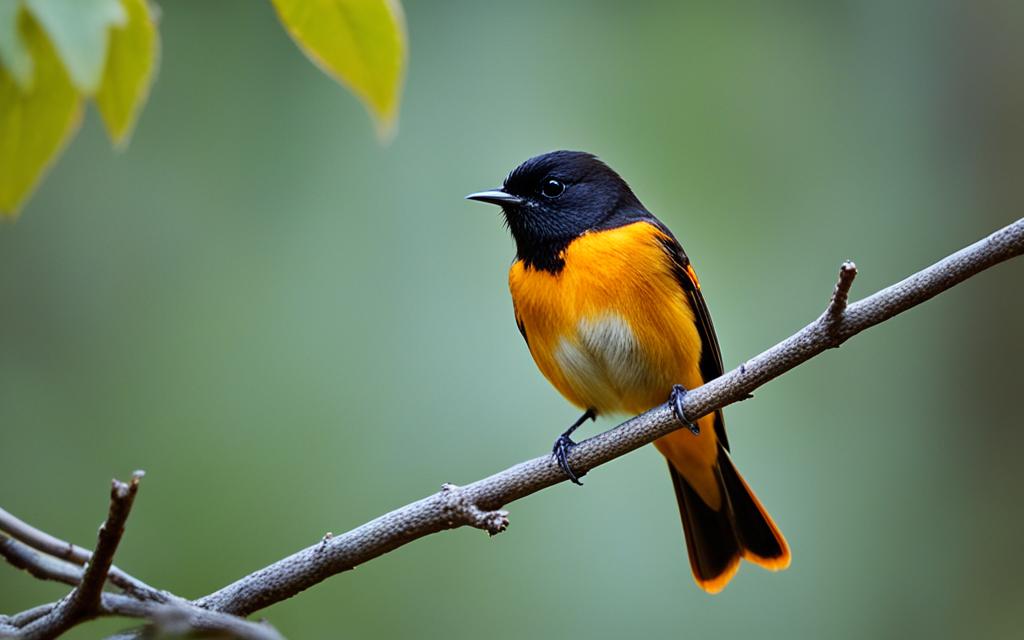
Notable Features of the American Redstart
| Characteristic | Description |
|---|---|
| Size | Small |
| Plumage | Black with orange patches (males) Olive-gray with yellow patches (females) |
| Range | Eastern United States and Canada |
| Habitat | Deciduous woodlands |
| Behavior | Insect-eating |
“The vibrant colors and energetic behavior of the american redstart make it a true delight to observe in the wild.” – Birdwatching enthusiast
Conclusion
Black and orange birds are a fascinating group of species that captivate birdwatchers and nature enthusiasts alike. Their vibrant plumage, unique behaviors, and migratory patterns make them a delight to observe and appreciate.
By understanding their habitat preferences, you can create a welcoming environment in your own backyard to attract these stunning birds. Providing the right resources such as feeders with fruit or nectar, and native berry plants, can entice black and orange birds to visit and stay.
Whether you’re interested in bird identification, birdwatching, or bird photography, these captivating creatures offer endless opportunities. Their melodious songs, intricate nests, and playful behaviors add a touch of magic to any birding expedition. So grab your binoculars and explore the enchanting world of black and orange birds!
FAQ
How can I identify black and orange birds?
Black and orange birds can be identified by their distinctive plumage, which usually includes a combination of black, orange, and sometimes white or yellow. Each species has its unique features, such as wing patches or markings on the head, that can help with identification.
Where can I find black and orange birds?
Black and orange birds can be found in various habitats around the world. Depending on the species, you may find them in wetlands, forests, grasslands, or deserts. In North America, for example, you can spot them during their breeding season in specific regions.
What is the migration pattern of black and orange birds?
Migration patterns vary among black and orange bird species. Some migrate long distances, while others stay in one area throughout the year. Understanding the migration patterns can help determine the best time and place to observe these birds.
How can I attract black and orange birds to my backyard?
To attract black and orange birds to your backyard, you can provide food sources that cater to their preferences. For example, orioles are attracted to fruit and nectar feeders, while other species may be drawn to bird feeders with mixed grains and seeds.
Are there any endangered black and orange bird species?
Some black and orange bird species, such as the hooded oriole, are not currently considered endangered. However, habitat loss and other threats can impact their populations. Supporting conservation efforts and providing suitable habitats are essential for their long-term survival.

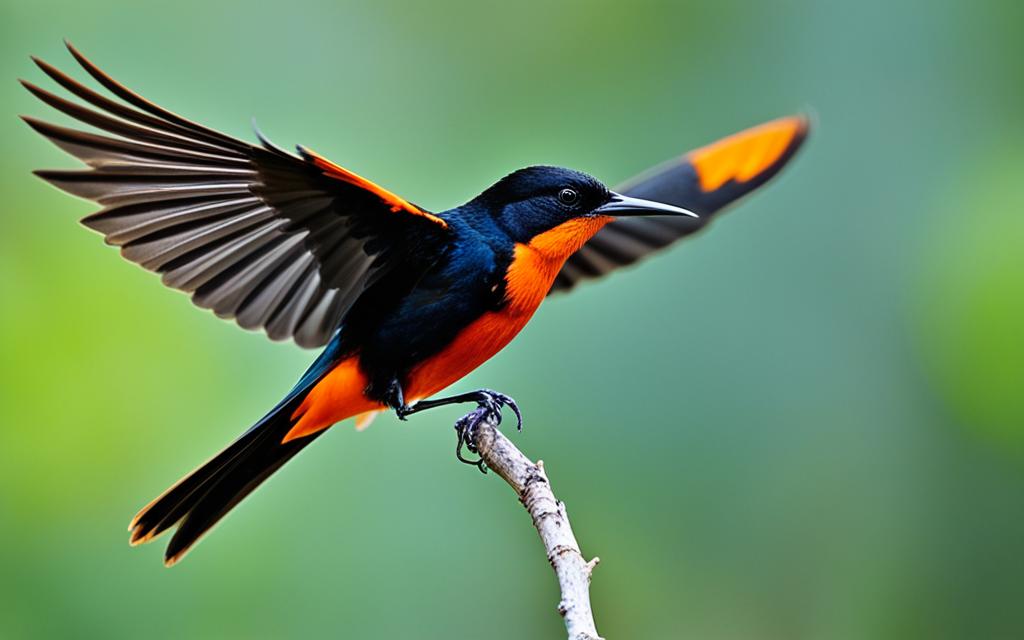
Comments are closed